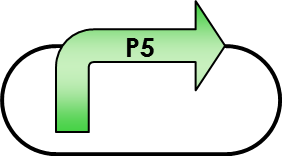Part:BBa_K404103
p5 promoter
| p5 promoter | |
|---|---|

| |
| BioBrick Nr. | BBa_K404103 |
| RFC standard | RFC 10 |
| Requirement | pSB1C3 |
| Source | pAAV_RC from Stratagene |
| Submitted by | [http://2010.igem.org/Team:Freiburg_Bioware FreiGEM 2010] |
The p5 promoter, located downstream of the rep and cap ORF (Figure 1: The p5 promoter of the wtAAV-2 is located upstream of the rep and cap ORF and contains several elements, which interact with Rep and endogenous proteins.)of the wtAAV-2, regulates gene expression of the two larger non-structural proteins Rep 78 and Rep 68 that are essential in genome replication and viral genome integration into several hotspots of the human chromosome.
Several binding elements for cellular and viral proteins involved in regulation can be found in the p5 promoter(Figure 1) therefore playing an important role in gene transcription, integration and replication, dependent on the presence or absence of helper viruses such as adenovirus (Ad) or herpes simplex virus (HSV) (Murphy et al. 2007). Besides regulation of gene expression, the p5 integration efficient element (p5IEE) containing the rep binding element (RBE) and a terminal resolution site (trs) is responsible for mediating site specific integration into the human genome (Philpott et al. 2002).
 Figure 1: The p5 promoter of the wtAAV-2 is located upstream of the rep and cap ORF and contains
Figure 1: The p5 promoter of the wtAAV-2 is located upstream of the rep and cap ORF and containsseveral elements, which interact with Rep and endogenous proteins .
Containing two consensus sequences for binding immediate early E1A gene product from adenoviruses (Chang et al. 1989), p5 promoter is transactivated in the presence of helper viruses whereas suppression occurs in absence of adenoviral proteins by low levels of Rep proteins (Beaton et al. 1989). Regulating of Rep78/68 by its negative feedback loop is critical since overexpression leads to cell cycle arrest in the S-phase (Berthet et al. 2005) and suppression of cellular promoters (Jing et al. 2001).
Characterization
P5 promoter activity was characterized by using the measurement for eukaryotic promoters proposed by the iGEM team Heidelberg 2009. Since we wanted to compare the promoter strength of a viral promoter we used the production cell line AAV-293 derived from the human embryonic kidney cells (HEK 293). Further aberrations are that we are comparing the natural p5 promoter with the CMV promoter and the p40 promoter driving cap transcription. AAV-293 cells were transfected with plasmids containing the p5, p40 and CMV promoter respectively and harvested after 48 hours. Total mRNA was isolated and reverse transcribed. Promoter strength was determined by quantitative real-time PCR.
- 10COMPATIBLE WITH RFC[10]
- 12COMPATIBLE WITH RFC[12]
- 21COMPATIBLE WITH RFC[21]
- 23COMPATIBLE WITH RFC[23]
- 25COMPATIBLE WITH RFC[25]
- 1000INCOMPATIBLE WITH RFC[1000]Illegal BsaI site found at 136
References
Beaton, a., Palumbo, P. & Berns, K.I., 1989. Expression from the adeno-associated virus p5 and p19 promoters is negatively regulated in trans by the rep protein. Journal of virology, 63(10), 4450-4.Berthet, C. et al., 2005. How adeno-associated virus Rep78 protein arrests cells completely in S phase. Proceedings of the National Academy of Sciences of the United States of America, 102(38), 13634-9.
Chang, L.S., Shi, Y. & Shenk, T., 1989. Adeno-associated virus P5 promoter contains an adenovirus E1A-inducible element and a binding site for the major late transcription factor. Journal of virology, 63(8), 3479-88.
Jing, X.J. et al., 2001. Inhibition of adenovirus cytotoxicity, replication, and E2a gene expression by adeno-associated virus. Virology, 291(1), 140-51. Available at: http://www.ncbi.nlm.nih.gov/pubmed/11878883. Murphy, M. et al., 2007. Adeno-associated virus type 2 p5 promoter: a rep-regulated DNA switch element functioning in transcription, replication, and site-specific integration. Journal of virology, 81(8), 3721-30.
Philpott, N.J. et al., 2002. A p5 integration efficiency element mediates Rep-dependent integration into AAVS1 at chromosome 19. Proceedings of the National Academy of Sciences of the United States of America, 99(19), 12381-5.
//function/regulation/transcriptional
//promoter
//viral_vectors
//viral_vectors/aav
//viral_vectors/aav/miscellaneous
| None |
